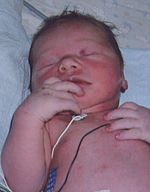Blue Baby Syndrome
| Blue baby syndrome | |
|---|---|
 |
|
| A cyanotic newborn, or "blue baby". Note the blue coloration of the fingertips. |
|
| Classification and external resources |
Blue baby syndrome refers to at least two situations that lead to cyanosis in infants: cyanotic heart disease and methemoglobinemia. The most common cyanotic heart defects include transposition of the great arteries, tetralogy of Fallot, persistent truncus arteriosus, tricuspid atresia and total anomalous pulmonary venous return.
A number of cardiovascular defects may lead to Blue baby syndrome, including the following:
Persistent (or patent) truncus arteriosus
Transposition of the great vessels
Anomalous pulmonary venous connection
The most common cause of blue baby syndrome, and the one which was the subject of the classic "blue baby operation" developed at Johns Hopkins in the 1940s, is tetralogy of Fallot. In the normal heart, there are four separate chambers; the two top chambers, or atria, pump blood simultaneously into the two bottom chambers, or ventricles. Blood first enters the heart at the right atrium, which then empties blood into the right ventricle, which pumps the blood into the lungs through the pulmonary artery to get oxygen. From the lungs, the blood enters the left atrium through the pulmonary vein; the left atrium empties into the left ventricle, which pumps the blood into the aorta and from there reaches the rest of the body. Because the left ventricle is responsible for getting blood to the entire body through the aorta, it is usually the biggest and strongest chamber of the heart.
After the body uses up the oxygen delivered by the blood flowing through the arteries, then arterioles, then capillaries, the unoxygenated blood returns to the heart by the capillaries, then venules, then veins.
...
Wikipedia
